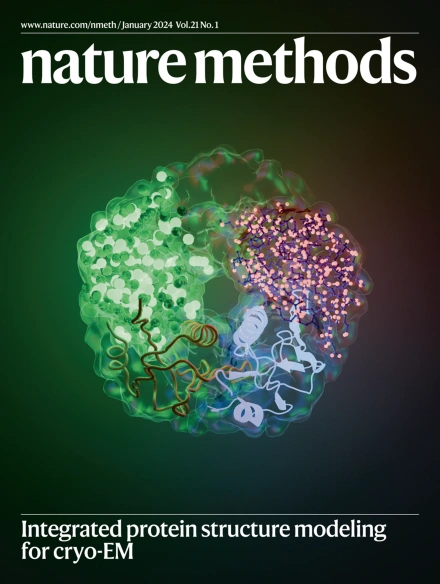挑战Astral质谱分析仪,以前所未有的精度量化每个单细胞多达5300个蛋白质,以揭示细胞异质性。
IF 36.1
1区 生物学
Q1 BIOCHEMICAL RESEARCH METHODS
引用次数: 0
摘要
尽管在样品制备、仪器和数据分析方面取得了重大进展,但单细胞蛋白质组学目前受到蛋白质组学深度和定量性能的限制。在这里,我们展示了高度改进的蛋白质组覆盖深度以及超低输入量量化的准确性和精度。使用定制的文库,我们以每天50个样品的吞吐量从250 pg的HeLa细胞肽中鉴定多达7400个蛋白质组。使用两个蛋白质组组合,我们检查了量化的最佳参数,并表明2的折叠变化差异仍然可以在单细胞水平输入中成功确定。最终,我们将我们的工作流程应用于A549细胞,根据细胞大小和使用的搜索策略,从单个细胞中获得从1801到最多bbb5300个蛋白质组的蛋白质组覆盖范围,这允许研究细胞大小和细胞周期阶段之间的依赖性。此外,我们的工作流程使我们能够区分两种人类胚泡谱系的体外类似物:幼稚的人类多能干细胞(外胚层)和滋养外胚层样细胞。我们的数据与转录组学数据一致,表明单细胞蛋白质组学具有识别囊胚内生物学相关差异的能力。本文章由计算机程序翻译,如有差异,请以英文原文为准。

Challenging the Astral mass analyzer to quantify up to 5,300 proteins per single cell at unseen accuracy to uncover cellular heterogeneity
Despite significant advancements in sample preparation, instrumentation and data analysis, single-cell proteomics is currently limited by proteomic depth and quantitative performance. Here we demonstrate highly improved depth of proteome coverage as well as accuracy and precision for quantification of ultra-low input amounts. Using a tailored library, we identify up to 7,400 protein groups from as little as 250 pg of HeLa cell peptides at a throughput of 50 samples per day. Using a two-proteome mix, we check for optimal parameters of quantification and show that fold change differences of 2 can still be successfully determined at single-cell-level inputs. Eventually, we apply our workflow to A549 cells, yielding a proteome coverage ranging from 1,801 to a maximum of >5,300 protein groups from a single cell depending on cell size and search strategy used, which allows for the study of dependencies between cell size and cell cycle phase. Additionally, our workflow enables us to distinguish between in vitro analogs of two human blastocyst lineages: naive human pluripotent stem cells (epiblast) and trophectoderm-like cells. Our data harmoniously align with transcriptomic data, indicating that single-cell proteomics possesses the capability to identify biologically relevant differences within the blastocyst. An ultra-low-input single-cell proteomic workflow is optimized to yield maximum proteome coverage with high accuracy and precision on the Orbitrap Astral mass spectrometer.
求助全文
通过发布文献求助,成功后即可免费获取论文全文。
去求助
来源期刊

Nature Methods
生物-生化研究方法
CiteScore
58.70
自引率
1.70%
发文量
326
审稿时长
1 months
期刊介绍:
Nature Methods is a monthly journal that focuses on publishing innovative methods and substantial enhancements to fundamental life sciences research techniques. Geared towards a diverse, interdisciplinary readership of researchers in academia and industry engaged in laboratory work, the journal offers new tools for research and emphasizes the immediate practical significance of the featured work. It publishes primary research papers and reviews recent technical and methodological advancements, with a particular interest in primary methods papers relevant to the biological and biomedical sciences. This includes methods rooted in chemistry with practical applications for studying biological problems.
 求助内容:
求助内容: 应助结果提醒方式:
应助结果提醒方式:


